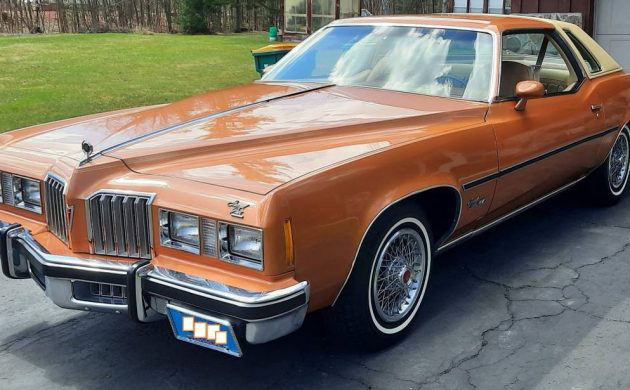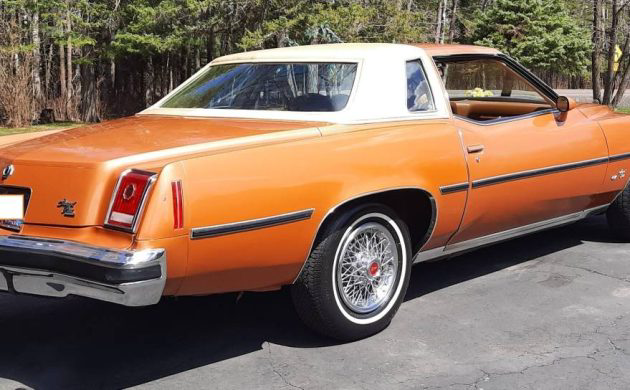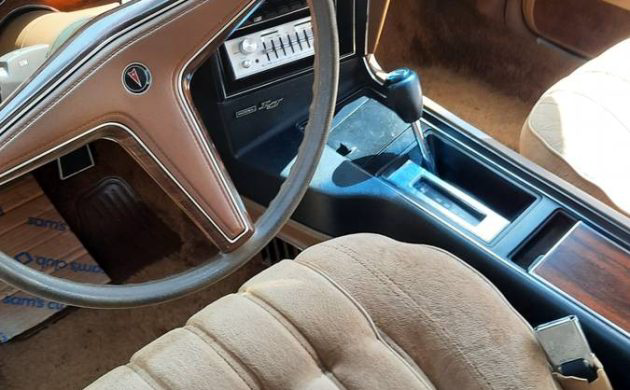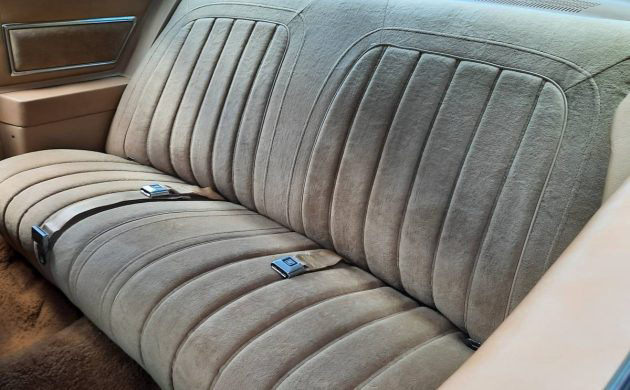1977 was the high-water mark for Pontiac’s Grand Prix in regards to sales as a record 288,430 units found new garages and driveways across America. It would also be the last of the “Boulevard Cruisers” and the successful fourth generation Grand Prix because downsized, boxy styling was right around the corner. (The ’78 Grand Prix would be about a foot shorter and 600 pounds lighter and didn’t come anywhere close to having the “presence” of the ’77 models.) For 1977, buyers could order a base Grand Prix J, the sporty SJ, or the top-of-the-line, luxury-focused LJ. As is typical with many craigslist ads, it’s very light on the car’s back history, descriptions, and photos (only seven are supplied with no engine photos). But based on the scant description and photos, it appears to be a nice-looking ’77 Grand Prix LJ and the claims of it having only 66,000-miles on the clock could be true. Another thank you to Tony Primo for sending this peachy-looking Poncho our way.
The seller doesn’t say if that’s the original, and very-1970ish Mandarin Orange paint or not, but it looks presentable with no rust or dents or major scratches spotted. The tan landau vinyl roof looks good as does all of the shiny stuff, trim, glass, and the new-for-’77 Grand Prix hood ornament. The wire wheel covers look like they’d be better suited on a Pontiac LeMans or Astra. You see most Grand Prix fitted with the 5-spoke, mag-type Rally II wheels. Although it didn’t receive major restyling, the ’77 Grand Prix looks wider thanks to the reworked front end that positioned the parking lamps between the quad headlamps. And the “waterfall” grill continues from the previous year but is narrower and extends down to the lower part of the bumper.
The oh-so-70’s tan velour interior appears to be well preserved as well. The comfy front bucket seats (with a wood appliqué console and automatic transmission shifter) and rear bench seat are showing minimal wear, the carpet looks good, and I’m spotting round aftermarket speakers in the door panel to support the car’s AM/FM/ 8 Track unit. The seller states the Grand Prix is equipped with power windows, power locks, a trunk release, AC, and cruise control. Nothing is mentioned if they’re in working order or not.
For some inexplicable reason, the seller chose not to show any photos of the engine. Thankfully, this Grand Prix is listed as having the optional 350-cubic inch V8 instead of the standard 301 V8 which, let’s face it, was just too small and underpowered for a 4,000-lb. car. The odometer is listed at 66,000 but there’s no mention if those are the original miles or if there’s paper work to prove it. The Grand Prix was first offered for the 1962 model year and tried to strike a balance between luxury and performance. But by 1977, personal luxury was the name of the game, not performance. “Built to be a boulevard cruiser, not a dragstrip bruiser,” accurately describes this, and thousands of other 1977 Pontiac Grand Prix survivors out there. Currently residing in Superior, Wisconsin, this Poncho is for sale here on craigslist with a reasonable asking price of $15,500. Have you ever driven one of these boulevard cruisers?





My 77 SJ was that color. Sweet ride.
I’m sorry!
Loved the Gran Prix from 69 to 77. Had 3 during my lifetime and they were great cars. Wish this one was a little closer to home.
Motorcityman doesn’t seem to like them. People of Detroit are very weird. Not many there now days.
I had a triple black 77, with a electric sunroof, and bucket seats. You hardly see these on the road anymore.
I had a 77 LJ back in the 80’s. Used of course, but it was a dream to drive. Sadly I had the 301 and it was flat out terrible. Replaced the engine once and then it did the same thing. Bad valves.
I also was in a terrible wreck once with it. A tow truck pulled into my lane of travel on a highway. I had to slam brakes and hit it. It literally blew the entire rear end out of the truck. Caved in my front end, lost 3 of 4 headlights, but the engine never even shut off. Radiator never even leaked. I drove it home!!!
You never felt any bumps in the road. It rode so smooth, unlike virtually everything made today.